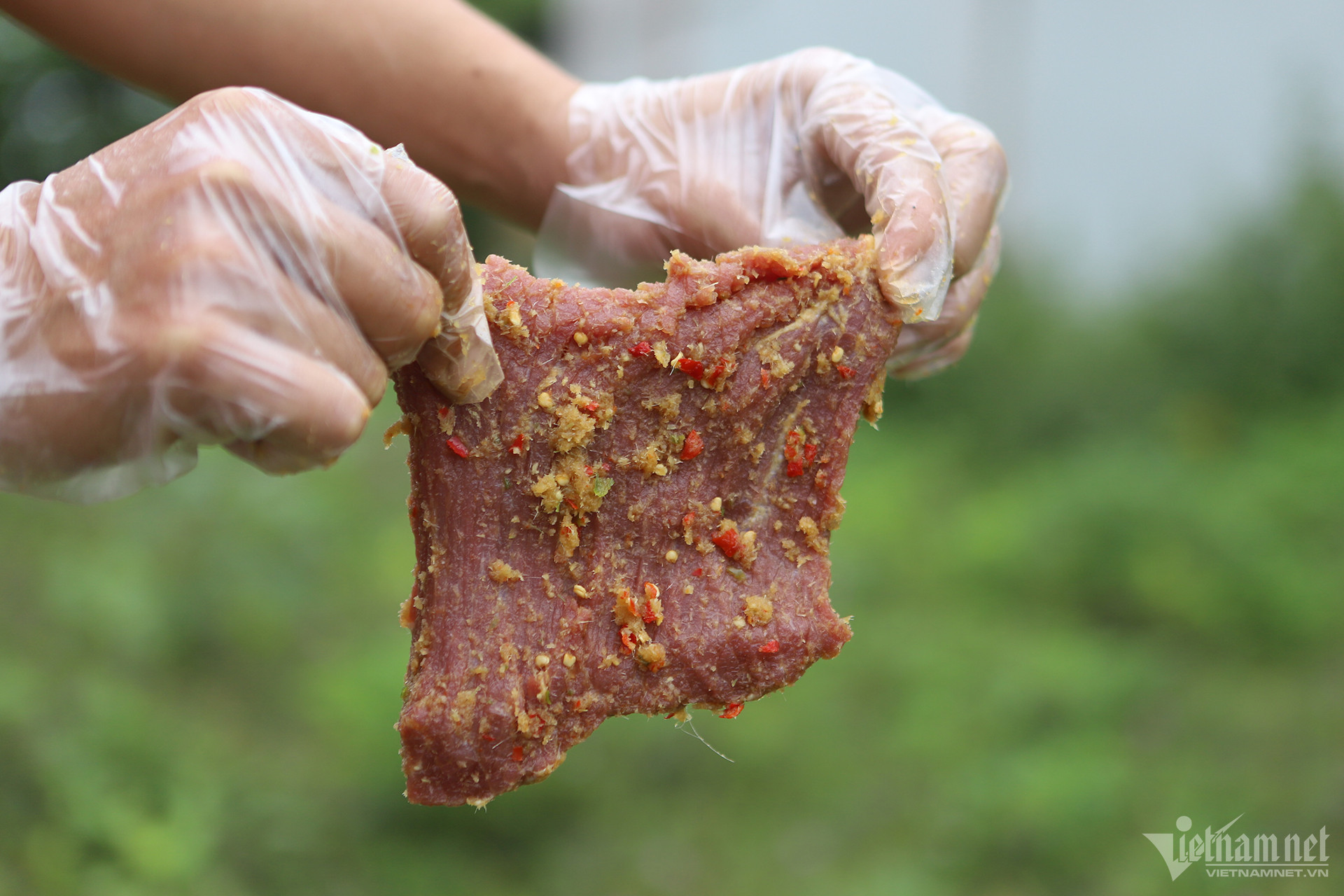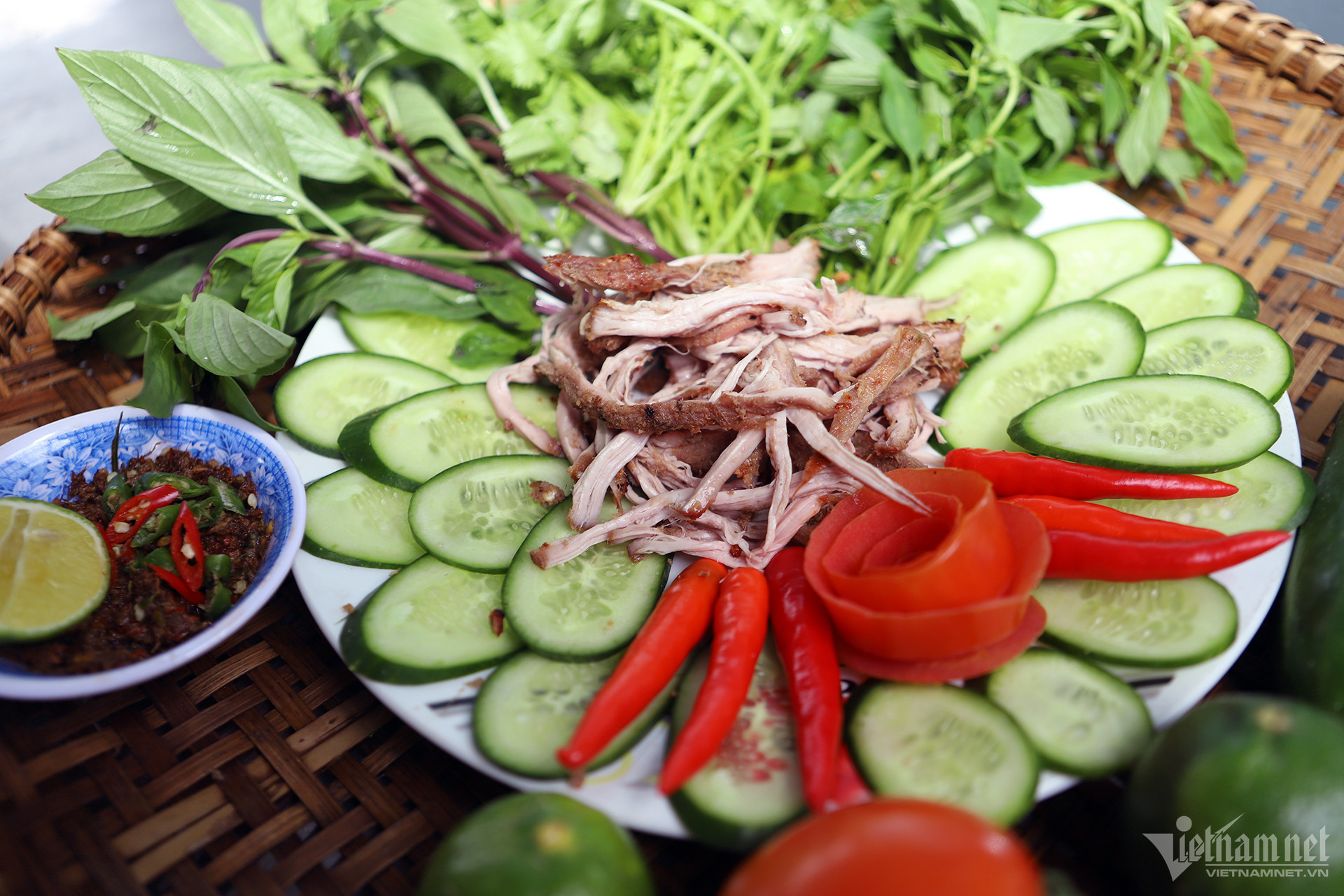Though their appearance may be intimidating, Phu Yen’s golden ant salt, tuna eyeballs, grilled lizard spring rolls, and armored boxfish are all renowned local specialties that offer bold and unforgettable flavors.
Golden ant salt
When visiting Phu Yen, tourists shouldn’t miss the chance to enjoy sun-dried beef dipped in golden ant salt. This region’s favorable climate allows native yellow cattle to thrive, producing high-quality beef for this dish.
The beef is sliced into large, hand-sized pieces along the grain to avoid toughness. It's then marinated for 3 to 4 hours with natural ingredients like lemongrass, finely chopped chili, and other signature local spices.
For the best flavor, the meat must be dried under intense sunlight for 5 to 6 hours. On overcast days, it is oven-dried at 35-40°C (95-104°F) for 4 to 5 hours. This crucial step tightens the meat fibers and gives it an attractive reddish-brown color.
Once dried, the beef is vacuum-sealed for hygiene and packed with golden ant salt for dipping.
True to its name, the salt is made from the bodies of golden tree ants, which nest high in treetops. The ants and their eggs are roasted until dry, then pounded with chili, salt, water celery, Vietnamese coriander, and then len leaves to create a naturally rich and aromatic dip.
Catching ant nests in the forest is not easy and typically handled by local experts. The ants nest at varying heights depending on forest conditions.



Pacific tuna eyeballs
Phu Yen is dubbed Vietnam’s “Pacific tuna capital,” with annual catches reaching several thousand tons.
One of the region’s most unusual specialties is tuna eyeballs stewed with Chinese herbs, also called “ocean headlights.” These are taken from large tunas, each eyeball roughly the size of a rice bowl, weighing 100-300 grams.
Before cooking, the eyeballs are cleaned and deodorized by blanching in boiling salt water, then rinsed and trimmed of blood vessels.
The eyeballs are then placed in ceramic bowls or jars with herbs like jujube and goji berries, along with vegetables and seasoning. They are steamed for 20-30 minutes.
Depending on regional preferences, tuna meat or belly may be added to the stew. Diners often pair the dish with mustard greens or shredded perilla leaves to cut the richness.
Despite being a well-known delicacy in Phu Yen, many diners hesitate to try tuna eyeballs due to their daunting appearance.


Grilled lizard spring rolls (cha dong)
At first glance, these spring rolls resemble the typical pork or seafood variety, but the key ingredient here is the meat of the dong lizard.
The dong, which looks like a small monitor lizard, is about the size of a big toe and inhabits sandy areas along Phu Yen’s coast and other central provinces. Its appearance alone is enough to unsettle many first-time diners.
Experienced hunters say that late spring to early summer is the best time to catch dong lizards, as they are in their breeding season and full of meat.
Cooks skin the lizards, remove the organs, tails, and limbs, then finely chop or grind the meat with spices. The mixture is combined with wood ear mushrooms and dried vermicelli to make the filling.
Because dong lizards are wild-caught, their meat is firm, low in fat, and has a distinctive aroma. The rolls are best served with sweet-and-sour fish sauce or fermented anchovy sauce, along with fresh herbs and cucumber to balance the flavor.
Dong lizards are also prepared in other regional specialties such as grilled dong with chili salt or dong porridge.
Armored boxfish (ca bo hom)

Also known as “armored fish,” ca bo hom is a rare seafood species found along Vietnam’s south-central coast, particularly abundant and flavorful in Vung Ro Bay, Dong Hoa, Phu Yen.
This fish has a very hard skeleton and a skin patterned with black hexagonal scales, resembling a box. Its flesh is white, similar in appearance to chicken but firmer, tastier, and more fragrant.
For this reason, locals also refer to it as “ocean chicken” or “saltwater chicken.” On the market, ca bo hom can sell for several hundred thousand to over a million VND per kilogram, depending on size.
The larger the fish, the higher the price. Live fish are typically 8 to 10 USD/kg more expensive than frozen ones.
Ca bo hom can be steamed, cooked into porridge or soup, made into floss, or grilled - the latter being the most popular method.
PV